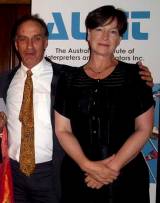
PRIVATE COLLECTION
Australia, 1972, 92 minutes, Colour.
Peter Reynolds, Pamela Stephenson, Brian Blain, Noel Ferrier, Grahame Bond, Les Foxcroft.
Directed by Keith Salvat.
Private Collection is a brief black comedy with more than a touch of satire. It was produced in Australia just at the time that the film industry was to break through into its renaissance, 1972, the year of The Adventures of Barry Mc Kenzie.
The film focuses on a husband and wife who actually employ the same thief to rob some of their art collection – they are both obsessed with the art collection and want to have more treasures. This leads to not only rivalry between the husband and wife but to ultimate violence.
The film is complicated by an inept thief, called George Kleptoman, who bungles his robbery – even to the extent of losing a hand from a guillotine which protects one of the art treasures.
British Peter Reynolds came to Australia to portray the husband. Pamela Stephenson who was to appear in a number of Australian films (Those Dear Departed) and make a name for herself on British television and later become a psychiatrist and wife of Billy Connolly as well as his biographer, is the wife. Popular comedian who portrayed Aunty Jack on television, Graham Bond, is the thief. Director Keith Salvat receives no further credit for any productions on the Internet Movie Data Base.
1. At what stage did you appreciate the thrust of this film? How important a film was it? How slight a film? What was the intention of the writer-director? Why was the film made?
2. How amusing a comedy was the film? Was it funny? Why?
3. How black was the comedy? How strong a satire? On human behaviour, on snobbery and greed, on the ordinary conventions of city, life husbands and wives, homes, collections, robberies? Did the deaths at the end of the film enhance the atmosphere or change it?
4. How did the film create its atmosphere? The style of the credits? the style of the characters, the use of the thirties music, the use of colour, the viewing of the private collection etc? Did the film seem real or was it in a fantasy-land?
5. How well were fantasy and reality balanced in the film?
6. What was your response to husband and wife? The scenes at home, going to the lecture, their response to their collection, horse-riding, the wife dancing, her lack of communication with her husband, did you like them?
7. What was the point of presenting the husband as shallow, greedy, with a heart condition? The nature of his dialogue, his pre-occupation with collection and riding? His plot to gain the Eagle? What satire on husbands and men did the film make?
8. How attractive was the wife? How different was it when we shared her memories? Did this bring her closer to the audience? In sympathy? Her relationship to her mother, the sailor? Her going to the lecture, her horse-riding, her dallying with the sailor? Her perpetual dancing, the significance of this? Her preparation of the food? Her final cruelty and greed and the finishing of the film with her satisfaction? What human behaviour was being satirized in her? (were the audience tricked in their response to her? Why?)
9. The caricature in the lecturer - the comment of what he was saying and the contrast with his reality? His likeness to the Eagle? The irony of his master-minding of the plot? His greed? The bizarre nature of his death? The point of this satire?
10. The robber - as inept, a professional, how comic was he (over-comic?)? His saving himself by entering the plot, his double-dealing, the suddenness of his death? The satire in the inept robber?
11. How callous was the ending with the husband's death? The cruelty of the wife? The number of deaths?
12. How did the film integrate elements of satire, exaggeration, farce, observation of society and life, humour and cruelty, violence? Was this a successful Australian film?